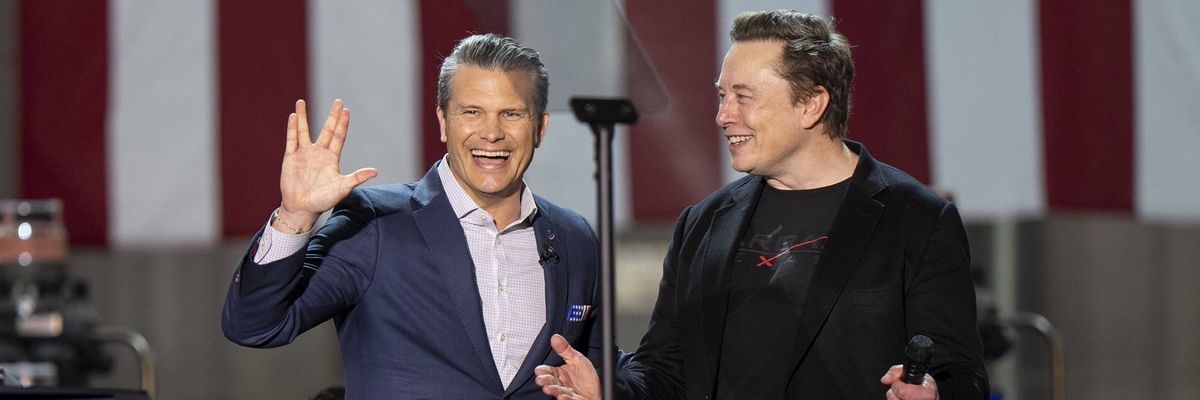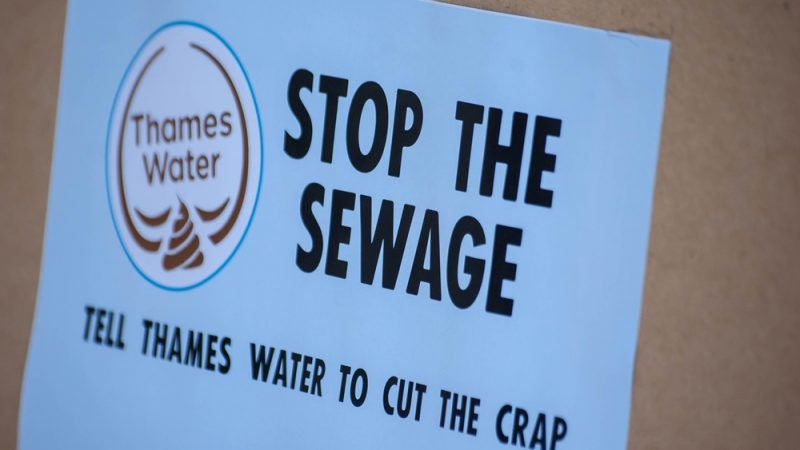Stephen Prager,
January 13, 2026

Elon Musk and U.S. Defence Secretary Pete Hegseth laugh at the Pentagon in Washington, D.C., U.S., March 21, 2025 in this screengrab obtained from a video. REUTERS/Idrees Ali
Elon Musk, the world’s richest man and the owner of the social media app X, has faced a mountain of outrage in recent weeks as his platform’s artificial intelligence chatbot “Grok” has been used to generate sexualized deepfake images of non-consenting women and children, and Musk himself has embraced open white nationalism.
But none of this seems to be of particular concern to Defense Secretary Pete Hegseth. Despite the swirl of scandal, he announced on Monday that Musk’s chatbot would be given intimate access to reams of military data as part of what the department described as its new “AI acceleration strategy.”
During a speech at the headquarters of SpaceX, another company owned by Musk, Hegseth stood alongside the billionaire and announced that later this month, the department plans to “make all appropriate data” from the military’s IT systems available for “AI exploitation,” including “combat-proven operational data from two decades of military and intelligence operations.”
As the Associated Press noted, it’s a departure from the more cautious approach the Biden administration took toward integrating AI with the military, which included bans on certain uses “such as applications that would violate constitutionally protected civil rights or any system that would automate the deployment of nuclear weapons.”
While it’s unclear if those bans remain in place under President Donald Trump, Hegseth said during the speech he will seek to eschew the use of any AI models “that won’t allow you to fight wars” and will seek to act “without ideological constraints that limit lawful military applications,” before adding that the Pentagon’s AI will not be “woke” or “equitable.”
He added that the department “will unleash experimentation, eliminate bureaucratic barriers, focus our investments, and demonstrate the execution approach needed to ensure we lead in military AI. He added that ”we will become an ‘AI-first’ warfighting force across all domains.
Hegseth’s embrace of Musk hardly comes as a surprise, given his role in the Trump administration’s dismantling of the administrative state as head of its so-called “Department of Government Efficiency” (DOGE) last year, and his record $290 million in support for the president’s 2024 election campaign.
But it is quite noteworthy given the type of notoriety Grok has received of late after it introduced what it called “spicy mode” for the chatbot late last year, which “allows users to digitally remove clothing from images and has been deployed to produce what amounts to child pornography—along with other disturbing behavior, such as sexualizing the deputy prime minister of Sweden,” according to a report last month from MS NOW (formerly MSNBC).
It’s perhaps the most international attention the bot has gotten, with the United Kingdom’s media regulator launching a formal investigation on Monday to determine whether Grok violated the nation’s Online Safety Act by failing to protect users from illegal content, including child sexual abuse material.
The investigation could result in fines, which, if not followed, could lead to the chatbot being banned, as it was over the weekend in Malaysia and Indonesia. Authorities in the European Union, France, Brazil, and elsewhere are also reviewing the app for its spread of nonconsensual sexual images, according to the New York Times.
It’s only the latest scandal involving the Grok, which Musk pitched as an “anti-woke” and “truth-seeking” alternative to applications like ChatGPT and Google’s Gemini.
At several points last year, the chatbot drew attention for its sudden tendency to launch into racist and antisemitic tirades—praising Adolf Hitler, accusing Jewish people of controlling Hollywood and the government, and promoting Holocaust denial.
Before that, users were baffled when the bot began directing unrelated queries about everything from cats to baseball back to discussions about Musk’s factually dubious pet theory of “white genocide” in South Africa, which the chatbot later revealed it was “instructed” to talk about.
Hegseth’s announcement on Monday also comes as Musk has completed his descent into undisguised support for a white nationalist ideology over the past week.
The billionaire’s steady lurch to the far-right has been a years-long process—capped off last year, with his enthusiastic support for the neofascist Alternative for Germany Party and apparent Nazi salute at Trump’s second inauguration.
But his racist outlook was left impossible to deny last week when he expressed support for a pair of posts on X stating that white people must “reclaim our nations” or “be conquered, enslaved, raped, and genocided” and that “if white men become a minority, we will be slaughtered,” necessitating “white solidarity.”
While details about the expansiveness of Grok’s use by the military remain scarce, Musk’s AI platform, xAI, announced in July that it had inked a deal with the Pentagon worth nearly $200 million (notably just a week after the bot infamously referred to itself as “MechaHitler”).
In September, reportedly following direct pressure from the White House to roll it out “ASAP,” the General Services Administration announced a “OneGov” agreement, making Grok available to every federal agency for just $0.42 apiece.
That same month, Sen. Elizabeth Warren (D-Mass.) sent a letter to Hegseth warning that Musk, who’d also used Grok extensively under DOGE to purge disloyal government employees, was “gaining improper advantages from unique access to DOD data and information.” She added that Grok’s propensity toward “inaccurate outputs and misinformation” could “harm DOD’s strategic decisionmaking.”
Following this week’s announcement, JB Branch, the Big Tech accountability advocate at Public Citizen, said on Tuesday that, “allowing an AI system with Grok’s track record of repeatedly generating nonconsensual sexualized images of women and children to access classified military or sensitive government data raises profound national security, civil rights, and public safety concerns.”
“Deploying Grok across other areas of the federal government is worrying enough, but choosing to use it at the Pentagon is a national security disgrace,” he added. “If an AI system cannot meet basic safety and integrity standards, expanding its reach to include classified data puts the American public and our nation’s safety at risk.”
“If an AI system cannot meet basic safety and integrity standards, expanding its reach to include classified data puts the American public and our nation’s safety at risk,” said a tech expert at Public Citizen.

Secretary of Defense Pete Hegseth stands with Elon Musk at the headquarters of his company SpaceX in Starbase, Texas on January 12, 2025.
(Photo from Secretary of Defense Pete Hegseth)
Stephen Prager
Jan 13, 2026
COMMON DREAMS
Elon Musk, the world’s richest man and the owner of the social media app X, has faced a mountain of outrage in recent weeks as his platform’s artificial intelligence chatbot “Grok” has been used to generate sexualized deepfake images of nonconsenting women and children, and Musk himself has embraced open white nationalism.
But none of this seems to be of particular concern to Defense Secretary Pete Hegseth. Despite the swirl of scandal, he announced on Monday that Musk’s chatbot would be given intimate access to reams of military data as part of what the department described as its new “AI acceleration strategy.”
During a speech at the headquarters of SpaceX, another company owned by Musk, Hegseth stood alongside the billionaire and announced that later this month, the department plans to “make all appropriate data” from the military’s IT systems available for “AI exploitation,” including “combat-proven operational data from two decades of military and intelligence operations.”
As the Associated Press noted, it’s a departure from the more cautious approach the Biden administration took toward integrating AI with the military, which included bans on certain uses “such as applications that would violate constitutionally protected civil rights or any system that would automate the deployment of nuclear weapons.”
While it’s unclear if those bans remain in place under President Donald Trump, Hegseth said during the speech he will seek to eschew the use of any AI models “that won’t allow you to fight wars” and will seek to act “without ideological constraints that limit lawful military applications,” before adding that the Pentagon’s AI will not be “woke” or “equitable.”
He added that the department “will unleash experimentation, eliminate bureaucratic barriers, focus our investments, and demonstrate the execution approach needed to ensure we lead in military AI. He added that ”we will become an ‘AI-first’ warfighting force across all domains.
Hegseth’s embrace of Musk hardly comes as a surprise, given his role in the Trump administration’s dismantling of the administrative state as head of its so-called “Department of Government Efficiency” (DOGE) last year, and his record $290 million in support for the president’s 2024 election campaign.
But it is quite noteworthy given the type of notoriety Grok has received of late after it introduced what it called “spicy mode” for the chatbot late last year, which “allows users to digitally remove clothing from images and has been deployed to produce what amounts to child pornography—along with other disturbing behavior, such as sexualizing the deputy prime minister of Sweden,” according to a report last month from MS NOW (formerly MSNBC).
The investigation could result in fines, which, if not followed, could lead to the chatbot being banned, as it was over the weekend in Malaysia and Indonesia. Authorities in the European Union, France, Brazil, and elsewhere are also reviewing the app for its spread of nonconsensual sexual images, according to the New York Times.
It’s only the latest scandal involving the Grok, which Musk pitched as an “anti-woke” and “truth-seeking” alternative to applications like ChatGPT and Google’s Gemini.
At several points last year, the chatbot drew attention for its sudden tendency to launch into racist and antisemitic tirades—praising Adolf Hitler, accusing Jewish people of controlling Hollywood and the government, and promoting Holocaust denial.
Before that, users were baffled when the bot began directing unrelated queries about everything from cats to baseball back to discussions about Musk’s factually dubious pet theory of “white genocide” in South Africa, which the chatbot later revealed it was “instructed” to talk about.
Hegseth’s announcement on Monday also comes as Musk has completed his descent into undisguised support for a white nationalist ideology over the past week.
The billionaire’s steady lurch to the far-right has been a years-long process—capped off last year, with his enthusiastic support for the neofascist Alternative for Germany Party and apparent Nazi salute at Trump’s second inauguration.
But his racist outlook was left impossible to deny last week when he expressed support for a pair of posts on X stating that white people must “reclaim our nations” or “be conquered, enslaved, raped, and genocided” and that “if white men become a minority, we will be slaughtered,” necessitating “white solidarity.”
While details about the expansiveness of Grok’s use by the military remain scarce, Musk’s AI platform, xAI, announced in July that it had inked a deal with the Pentagon worth nearly $200 million (notably just a week after the bot infamously referred to itself as “MechaHitler”).
In September, reportedly following direct pressure from the White House to roll it out “ASAP,” the General Services Administration announced a “OneGov” agreement, making Grok available to every federal agency for just $0.42 apiece.
That same month, Sen. Elizabeth Warren (D-Mass.) sent a letter to Hegseth warning that Musk, who’d also used Grok extensively under DOGE to purge disloyal government employees, was “gaining improper advantages from unique access to DOD data and information.” She added that Grok’s propensity toward “inaccurate outputs and misinformation” could “harm DOD’s strategic decisionmaking.”
Following this week’s announcement, JB Branch, the Big Tech accountability advocate at Public Citizen, said on Tuesday that, “allowing an AI system with Grok’s track record of repeatedly generating nonconsensual sexualized images of women and children to access classified military or sensitive government data raises profound national security, civil rights, and public safety concerns.”
“Deploying Grok across other areas of the federal government is worrying enough, but choosing to use it at the Pentagon is a national security disgrace,” he added. “If an AI system cannot meet basic safety and integrity standards, expanding its reach to include classified data puts the American public and our nation’s safety at risk.”







